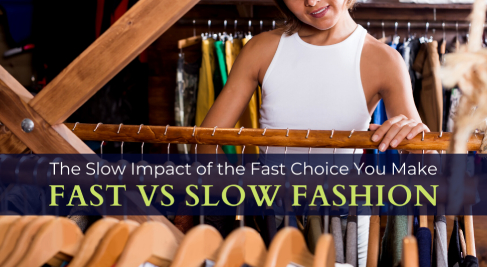It is often said that life is a series of all the choices we make. And so is nature. The choices we make – form, make, and depletes our future and the future of the nature around us.
And these choices are so deeply rooted that the very first choice of the cloth you choose to wear in the morning, decides the future of our climate. It’s the choice of fast vs slow fashion.
Countless fashion customers and purchasers tend to be unaware of the implications of their purchase decisions, as well as the effects of slow and fast fashion on our relationships with our environment, communities, and ourselves. And deciding between fast and slow fashion isn\’t only a matter of taste: it\’s also a matter of values.
But what is this fast vs slow fashion revolution all about? Let’s weave our way to understand the differences.
WHAT ARE FAST AND SLOW FASHION?
Well, first things first – we would rather refer to this fast vs slow fashion as fast fashion vs sustainable fashion.
Fast fashion refers to low-cost, mass-produced apparel that closely resembles the latest trends seen on pop charts and at runway shows.
Fashion trends change quickly, and with fashion businesses chasing higher profits, the sector has descended into a downward spiral.
To stay ahead of the competition and meet client expectations, manufacturers mass-produce clothing at breakneck speed.
When you toss away that quick fashion clothing, what happens to it? It\’ll very certainly wind up in a landfill. The world\’s landfills are already overflowing, and fast fashion\’s popularity has pushed individuals to contribute to the pile. Most individuals can\’t cling to their garments even if they wanted to since quick fashion is purposefully created with low-quality materials.
Slow fashion makes use of ethical, environmentally friendly materials that are designed to last for years. It has a significantly longer turnaround time and is generally more expensive, but we believe the benefits outweigh the disadvantages. Investing in slow fashion pieces that will last a lifetime rather than rapid fashion pieces that will fall apart after a few months can save you money.
The fundamentals of slow fashion are as follows:
- Rather than rip-offs, original designs are created.
- Using resources that are both sustainable and ethically sourced.
- Making items that can be worn for many years.
- Focusing on the future rather than the present.
- Reduce the amount of waste that ends up in landfills.
- Rather than following fads, I want to stick to classic styles.
- Providing high-quality clothing that is both accessible and cheap.
- Experienced designers, seamstresses, and craftspeople are employed.
- Ethical Pay to workers including Healthy working conditions and a conducive environment to work in
- Fair pay to all individuals of the supply chain from supplier to garment worker to quality checker to packer.
- Promoting and creating garments using artisanal skills of a largely underpaid community. This includes hand-stitched, weaving, hand embroidery and other custom ways of designing.
- Transparent Value and Supply chain from raw material to the finished product.
Are Top Garment Manufacturers in India concerned about this choice?
The answer is yes. And no.
Not all Top Garment Manufacturers in India are conscious about the choice of producing ethical fashion.
There are bespoke clothing manufacturers for start-ups and big labels who ethically source fabrics that produce the highest quality clothes. The ODD factory does exactly that.
O.D.D. honours and empowers the hands who put their heart and soul into making sure your garment is just WOW. We say ‘thank you\’ by providing ongoing training, skill development, and equitable and fair remuneration to our employees. During this occasion, we raise a glass to all of our karigars who have been with us since the beginning.
We a part of the #FashionRevolution #whomadeyourclothes #imadeyourclothes.
Read more about how The ODD Factory is contributing to the revolution of slow fashion – https://theoddfactory.com/what-slow-fashion



